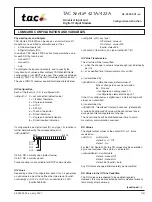
NI USB-6000 User Guide
|
© National Instruments
|
15
The ports can be configured as open collector using NI-DAQmx API, allowing operation with a
different voltage level when used in conjunction with an external user-provided pull-up resistor.
The connection for such a situation is as shown in Figure 9.
Figure 9.
Example of Connecting an External User-Provided Resistor
For more information about how to set the DIO configuration, refer to the KnowledgeBase
document,
Configuring NI Devices to be Open-Drain (Open Collector) or Push-Pull (Active
Drive)
. To access this document, go to
ni.com/info
and enter the Info Code
ex52
s
p
.
I/O Protection
To protect the NI USB-6000 against overvoltage, undervoltage, and overcurrent conditions, as
well as ESD events, you should use the following guidelines:
•
If you configure a DIO line as an output, do
not
connect it to any external signal source,
ground signal, or power supply.
•
If you configure a DIO line as an output, understand the current requirements of the load
connected to these signals. Do
not
exceed the specified current output limits of the DAQ
device.
National Instruments has several signal conditioning solutions for digital applications
requiring high current drive.
•
If you configure a DIO line as an input, do
not
drive the line with voltages outside of its
normal operating range. The DIO lines have a smaller operating range than the AI signals.
•
Treat the DAQ device as you would treat any static-sensitive device. Always properly
ground yourself and the equipment when handling the DAQ device or connecting to it.
Note
: Ensure that the current flowing across R
pull
does not violate the maximum sinking current specifications
(4 mA).
Extern
a
l
Lo
a
d
VCC
GND
47.5 k
Ω
On
b
o
a
rd
P
u
ll-Down
Re
s
i
s
tor
Extern
a
l
P
u
ll-Up
Re
s
i
s
tor
NI U
S
B-6000
P0.0 with O
u
tp
u
t Drive Type
S
et to Open Collector
V
p
u
ll-
u
p
(U
s
er Provided,
≤
5 V)
R
p
u
ll





































